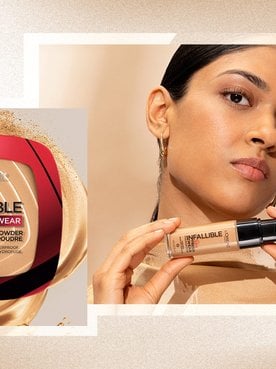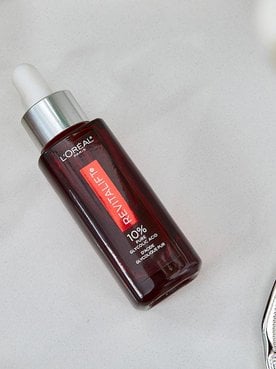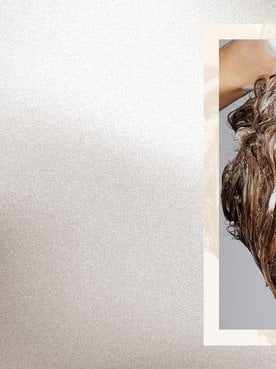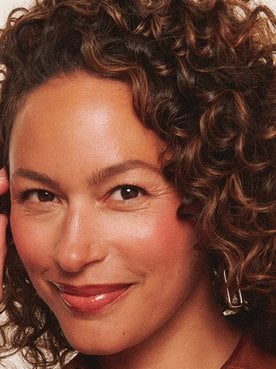Do you apply the primer or moisturizer first? Many people ask this question regarding the order of application of certain products. The answer is simple: you should always apply moisturizer before primer (yes, always).
There is a reason behind this order of application. Moisturizer hydrates the skin and preps it for makeup, while primer smooths pores and creates a barrier for foundation.
Face primer and moisturizer are both important—we’d argue essential—elements of proper skin prep. One thing is for sure: reversing the order of application can lead to cakiness or ineffective skin hydration..
Below, we’ll explain what makeup primer is, what it does, and how to use primer to create the ideal canvas for your makeup application. Plus, we’ll clue you in on a few of our favorite primers, offer tips on choosing the right primer and moisturizer for your needs, and more.
What’s the Difference Between Primer and Moisturizer?
Face primer and moisturizer are different products with different purposes—even though they may look (and in some cases, even feel) similar. This is true even if the primer you choose is a moisturizing or hydrating primer.
These products, while hydrating, aren’t meant to replace your daily moisturizer. Rather, they’re designed to be used after your daily hydration to give your skin an additional boost and help prep your skin for a seamless makeup application. (Consider it as supplemental moisture rather than the sole source of hydration your skin needs to look and feel its best). Besides, they are from two different families of cosmetic products: moisturizer is a skincare product, while primer is a makeup product.
What is a moisturizer and what does it do?
Moisturizer, as the name suggests, is a type of skincare product designed to help moisturize and hydrate your skin. Moisturizers can come in various formats, from lightweight lotions to thick, rich creams, and are a cornerstone of any effective skincare routine. Generally, they’re meant to be applied twice daily—once in the morning (after serum but before SPF) and once in the evening, usually as the final step of your nighttime skincare routine.
In addition to hydrating your skin, many moisturizers are designed to target skin concerns like dullness, dark spots, or visible fine lines and wrinkles. When choosing one, it’s best to seek out a formula designed for both your skin type and concerns (more on that in a bit).
What is makeup primer, and what does it do?
If you are new to primer, it's logical you are unclear about its function. What is primer used for? Primer is a makeup product designed to give your makeup an even base for a smooth application and help it last longer. The best way to think of primer is as a barrier for your skin and makeup products.
If you’re still wondering, “What does primer do that moisturizer doesn’t?” the answer is a lot. Depending on the formula, makeup primer can help mattify shine, minimize the appearance of pores, or help reduce discoloration. As mentioned above, many also help hydrate the skin, which makes it a sort of makeup moisturizer. If you’re after hydration, we suggest trying the L’Oréal Paris True Match Lumi Glotion Natural Glow Enhancer. This illuminating primer does it all—it helps hydrate the skin, preps it for makeup, and adds a subtle, natural-looking glow perfect for kicking off a dewy or glowy makeup look.

Should You Apply Primer Before or After Moisturizer?
Again, moisturizer first, then primer. The purpose of a moisturizer is to lock in moisture and help keep dryness at bay. If that is the case, what does makeup primer do? Primer readies your skin for a seamless makeup application. The primer makeup use is that. If you were to apply your products in the reverse order, you’d likely find that your moisturizer doesn’t hydrate your skin as effectively as it could. Following the wrong order could also result in your makeup pilling or sliding off your face entirely—and even if you managed a solid makeup application, it wouldn’t last as long as it would have if you applied primer after moisturizer. Next time the doubt “primer before or after moisturizer?” gets into your mind, you know the answer.
An easy way to remember the correct order is to separate your products into two separate routines. Moisturizer is skincare—so it should always be the last step in your skincare routine (unless it’s daytime, in which case, you should end your routine with sunscreen). Meanwhile, Primer is a makeup product and should always be the first step in your makeup routine.
Once you’ve applied your moisturizer and primer, you’re ready to start applying makeup. For a quick flushed look that’ll show off the skin you just prepped, try the L’Oréal Paris Lumi Le Liquid Blush. It offers a buildable flush of color with a dewy or glowy finish, depending on the shade you choose.
How Long Should You Wait Between Applying Moisturizer and Primer?
A big part of achieving a great makeup application is knowing how to apply makeup primer properly and taking the time to do so. You already know the answer to the question, “Does primer go on before or after moisturizer?”. Now, it is time to dive into the process. To ensure the best results, you should wait for a few minutes if you have time between smoothing on your moisturizer and sunscreen and applying your face primer. This allows the moisturizer to fully absorb into the skin and give it the nourishment it needs to look and feel its best. If you rush in, applying primer too soon can cause pilling or uneven foundation application.
If that feels like too many steps to follow on busy mornings, consider swapping out your go-to sunscreen for the L’Oreal Paris RevitaLiftTriple Power Moisturizer With SPF 30. It’s formulated with 3 of the top dermatologist-proven ingredients - Pro-Retinol, Hyaluronic Acid, and Vitamin C. It will give you up to 48 hours of hydration, plus, it’s suitable for sensitive skin, lightweight and non-greasy.
Editor’s tip: As it’s wise to wait a bit between applying your moisturizer and primer, you should also allow your primer time to dry down before applying the rest of your makeup. We suggest letting the primer sit for at least 30 seconds—or until it’s no longer “tacky”—before reaching for your foundation and concealer.
How To Choose the Right Primer and Moisturizer for You
When choosing the right primer and moisturizer for your skin type, it's important to consider your specific needs—with both products, different formulas have different benefits. We’re breaking down a few of our favorite products in both categories, below.
Oily or blemish-prone skin
Those with oily skin tend to do best with lightweight, water-based moisturizers that hydrate the skin without leaving it feeling heavy or greasy. We love the L’Oréal Paris RevitaLift Derm intensives Micro Hyaluronic Acid + Ceramides Line-Plumping Water Cream, which is suitable for all skin types and tones. Likewise, we recommend opting for a lightweight primer that won’t clog your pores or contribute to breakouts.

Dry and sensitive skin
If you have dry or sensitive skin, you’ll need products that provide deep nourishment and help boost your skin’s hydration. Most moisturizers will do this—that’s the point—but we’re fond of the L’Oréal Paris Collagen Moisture Filler Anti-Aging Moisturizer, which provides up to 48 hours of hydration and is gentle enough for all skin types. For primer, we suggest opting for a gentle formula that helps balance out your skin tone. The L’Oréal Paris Prime Lab Up to 24H Redness Eraser helps neutralize redness (a common concern for those with dry, sensitive skin) on fairer skin.
Mature skin
Mature skin often comes with its own set of concerns, such as uneven skin texture and tone. It can also be prone to dryness, which is why choosing the right moisturizer is a must. We love the L’Oréal Paris RevitaLift Triple Power Day Lotion SPF 30, which contains hyaluronic acid, pro-retinol, and vitamin C alongside broad-spectrum SPF 30 sunscreen. When priming your skin for makeup, reach for the L’Oréal Paris Prime Lab Up to 24H Pore Minimizer. It’s infused with a 1% blend of lipo, alpha, and beta-hydroxy acids and helps smooth the skin—both instantly and over time.
Next Up: Should You Apply Moisturizer or Sunscreen First?
Photo Courtesy of L'Oréal Paris







